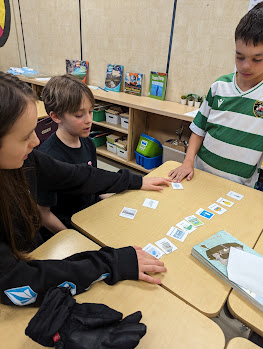March 11-15, 2024
Learning Outcomes
Science
-Recognize and appreciate the potential dangers involved in using sources of electrical currents
-Identify example applications of electrical devices in the school and home environment, and classify the kinds of uses. Categories of electrical use may include such things as: heating, lighting, communicating, moving, computing.
What Did Students Do?
Students continued with their exploration of electricity this week. They used Watt meters to measure the amount of watts being used by various devices such as a hair dryer, computer being charged, electric pencil sharpener, lamp, and walkie talkie. Students first estimated what watts each one would use and then completed the tests with the watt meters.
Through watching videos about electricity and using our activities from Green Calgary, we had the opportunity to discover how electrons move along a wire to create a circuit. Students worked together to create a circuit with electrons. Each student held a foam "Electron." They learned that the electrons can't move without an energy source. Once we added a "Battery" they were able to make their electrons move. We then added an electric lightbulb and a "Switch" to show an open and closed circuit and discover how switches turn electricity on and off. This week we will make actual circuits using batteries and bulbs, using the information we learned from our activity.
We then created electromagnets using wire, a battery, and a large nail. Students wound their wires tightly around the nail and then connected the ends of the wire to the D Battery. They used electrical tape to attach the wires. Some of our groups were successful in making their magnets and in being able to pick up small paper clips. Other groups struggled to get their wires tight enough and did not get the results they wanted. We will revisit this experiment later in our unit on electricity and magnetism.
In math we completed our unit on area, perimeter, and measurement. We are now in the process of assessing their knowledge on the concepts that were covered. Moving forward we will be introducing division and investigating divisibility by natural numbers to 10.
ELAL
All students should now be finished their Journey writing. This week they will take time to go over their writing using their COPS checklist. They will also be using their story writing rubric to assess their writing and choose one area to make improvements in. We hope you will take a moment to read your child's story and to look at the writing "Journey" we have taken through writing these stories. Students will carry the skills learned through this process into future independent writing tasks.
We continue to read our small group novels and are hoping to finish these by mid April.
Social Studies
We will complete our learning about Indigenous groups in Canada pre-contact this week. After the break we will explore the fur trade in Canada.
Ask Your Child About:
-Our practice lockdown on Friday - great work grade 5s!
-Basketball skills learned this week - we will play some games this week
-Our electricity activities
-Their Maker Space story they are working on
-Where they are at with their Journey writing
Upcoming Events
March 21st – Parent Teacher Conferences – 4:00 – 7:30
March 22nd – Parent Teacher Conferences – 8:00 – 1:00 No school for students
March 23rd – April 2nd – Spring Break
















